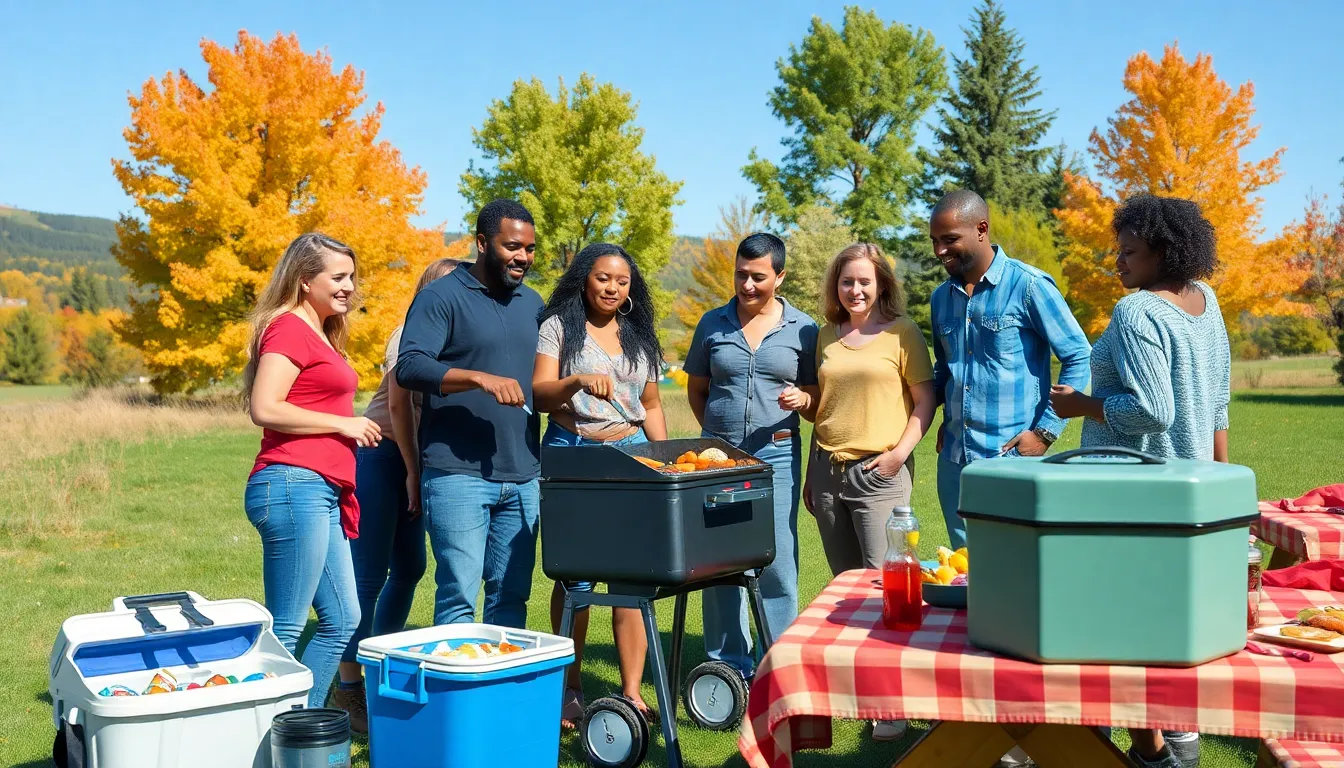There’s something magical about cooking outdoors. The fresh air, the sounds of nature, and the warmth of a fire create an experience that indoor cooking just can’t replicate. Whether it’s a family gathering in the backyard or a camping trip in the wilderness, outdoor cooking activities bring people together and ignite a sense of adventure.
Table of Contents
ToggleOverview of Outdoor Cooking Activities
Outdoor cooking encompasses a variety of techniques and practices that enhance the culinary experience in natural settings. The appeal lies in the unique elements of ambiance and social interaction, making it a popular choice for gatherings and adventures.
Benefits of Outdoor Cooking
Outdoor cooking offers several advantages that contribute to its popularity. These benefits include:
- Healthier Meals: Cooking outdoors promotes fresh, whole food preparation, often using seasonal ingredients.
- Enhanced Flavor: The outdoor environment allows for unique cooking methods, such as smoking or grilling, which elevate flavor profiles.
- Social Interactions: Gathering around a fire or grill fosters communal experiences, strengthening bonds among family and friends.
- Stress Relief: Being in nature reduces stress, while cooking outdoors can provide a sense of relaxation and enjoyment.
- Increased Physical Activity: Setting up cooking stations and managing fire or grills promotes physical engagement during the cooking process.
Popular Outdoor Cooking Methods
Various methods exist for outdoor cooking, each offering distinct experiences. Common techniques include:
- Grilling: Utilizing a grill provides direct heat, perfect for meats, vegetables, and seafood, creating a crispy exterior and juicy interior.
- Camping Stove Cooking: Portable stoves allow for easy meal preparation while camping, offering versatility and ease of use.
- Campfire Cooking: Cooking over an open flame, often using cast iron cookware, imparts unique flavors and creates memorable experiences.
- Smoking: Slow-cooking foods with wood chips infuses them with rich, smoky flavors, ideal for meats and fish.
- Foil Packet Cooking: Wrapping ingredients in aluminum foil and placing them over the heat stream retains moisture and flavors, facilitating easy cleanup.
These methods enhance outdoor culinary experiences, making each gathering a delightful adventure.
Equipment and Gear for Outdoor Cooking

Selecting the right equipment and gear enhances the outdoor cooking experience. Essential items vary based on the cooking method chosen and personal preferences.
Essential Tools for Outdoor Cooking
- Grill or Portable Stove: A reliable grill or portable stove ensures consistent heat for cooking. Options include charcoal grills, gas grills, or camping stoves, each providing unique flavors.
- Utensils: Quality utensils, such as spatulas, tongs, and grilling forks, facilitate safe food handling. Use heat-resistant materials like stainless steel or silicone to withstand outdoor conditions.
- Cookware: Durable cookware, including cast iron skillets, Dutch ovens, and grilling baskets, withstands high temperatures. Lightweight options like aluminum or non-stick cookware ease transport.
- Coolers: Insulated coolers maintain the freshness of ingredients and beverages. Choose models with thick walls and proper seals to retain cold air during outings.
- Cutting Boards and Knives: Portable cutting boards and sharp knives aid in food preparation. Folding or lightweight cutting boards are ideal for easy transport.
- Fire Starter: Fire starters, such as matches or lighters, facilitate campfire ignition. Choose waterproof or windproof options for reliability.
- Food Storage Bags and Containers: Resealable bags and airtight containers keep raw ingredients and leftovers fresh. Opt for BPA-free materials to ensure safety.
Safety Gear and Considerations
- First Aid Kit: A well-stocked first aid kit addresses minor injuries and accidents. Include antiseptic wipes, band-aids, and pain relievers for convenience.
- Fire Extinguisher or Bucket of Water: Keeping a fire extinguisher or a bucket of water nearby addresses fire-related emergencies. Know local fire regulations and conditions when cooking outdoors.
- Heat-Resistant Gloves: Using heat-resistant gloves prevents burns during food handling. Choose gloves made from silicone or thick fabric for optimal protection.
- Sun Protection: Sunscreen, hats, and sunglasses protect from sun exposure during outdoor cooking. Implement measures to avoid heat-related illnesses.
- Insect Repellent: Insect repellent keeps pests at bay during outdoor cooking sessions. Choose products containing DEET or natural alternatives like citronella for effectiveness.
- Water Supply: Sufficient water is essential for hydration and cleaning. Carry extra water bottles or a portable water filter to ensure access to clean water.
- Trash Bags: Proper waste disposal maintains cleanliness in outdoor settings. Use biodegradable bags to minimize environmental impact while leaving no trace.
Types of Outdoor Cooking Activities
Outdoor cooking activities encompass various techniques, each providing unique experiences and flavors. These methods not only elevate meals but also enhance social interactions in natural settings.
Grilling and Barbecuing
Grilling and barbecuing involve cooking food over direct heat, typically on a grill or in a smoker. Foods like meats, vegetables, and seafood benefit from methods that impart a smoky flavor and attractive grill marks. Popular techniques include:
- Direct grilling: Cooking food directly over flame for quick preparation.
- Indirect grilling: Placing food next to, rather than over, the heat source for longer cooking times, ideal for larger cuts of meat.
- Barbecue smoking: Cooking at lower temperatures for extended periods adds depth of flavor through the infusion of smoke from wood chips.
Grilling and barbecuing create an interactive atmosphere, allowing participants to engage while preparing their meals.
Campfire Cooking
Campfire cooking relies on an open flame as the heat source, offering a rustic and adventurous way to prepare food. This method includes:
- Skewering: Threading food on sticks to be cooked directly over the fire.
- Dutch oven cooking: Utilizing a heavy pot with a lid for slow-cooking stews and casseroles over the fire.
- Foil cooking: Wrapping ingredients in aluminum foil to cook them directly in the embers.
Campfire cooking encourages creativity, with participants experimenting with various ingredients for flavorful dishes while enjoying the warmth and ambiance of a fire.
Portable Stove Cooking
Portable stove cooking leverages compact camping stoves, providing convenience and versatility outdoors. Suitable for varied foods, this method features:
- Propane stoves: Efficient and quick heating for a variety of meals.
- Butane stoves: Lightweight options for simple cooking tasks, perfect for backpacking trips.
- Multifunctional stoves: Combining grilling, boiling, and simmering functions for increased versatility on outdoor excursions.
Portable stoves cater to both novice and experienced cooks, making meal preparation easy regardless of location.
Tips for Successful Outdoor Cooking
Successful outdoor cooking relies on thoughtful planning and proper execution. Adopting specific strategies enhances the overall experience and ensures delicious results.
Meal Planning and Preparation
Planning meals ahead simplifies the cooking process. Creating a detailed menu helps manage ingredients and cooking times. Utilize simple, crowd-pleasing recipes that don’t require extensive equipment. Consider pre-cooking or marinating foods at home to save time on-site. Preparing a checklist of needed ingredients and utensils minimizes forgotten items. Organize ingredients in labeled containers to streamline cooking. Pack non-perishable items separately from perishables to maintain freshness.
Ingredient Selection and Storage
Choosing high-quality ingredients promotes flavorful meals. Select fresh and seasonal produce for enhanced taste. Opt for lean meats and sustainable seafood when applicable. Use airtight containers to store perishable items to prevent spoilage. Keep ingredients cool in insulated bags or coolers, especially dairy and meats. Use ice packs to ensure temperature control. Avoid bringing excessive amounts to minimize waste and enable easier meal prep. Consider portion sizes to prevent overbuying and resulting food waste.
Outdoor cooking transforms meals into memorable experiences. The combination of fresh air and natural surroundings creates a unique atmosphere that fosters connection and adventure. Engaging in various cooking methods not only enhances flavors but also promotes healthier eating and social interactions.
With the right equipment and thoughtful planning, outdoor cooking can be both enjoyable and safe. By embracing the creativity of cooking outdoors, individuals can forge lasting memories with family and friends. This delightful activity encourages exploration and appreciation for nature while savoring delicious meals together. Whether it’s grilling under the stars or preparing a campfire feast, outdoor cooking offers endless opportunities for fun and connection.




